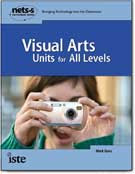From 2 Dimensions to 3D
I taught Fine Arts in middle schools in East Harlem, NYC for close to 2 decades. I think one of the most important challenges I tackled during that part of my career as an educator was teaching kids to draw – I mean REALLY DRAW. Over the years I developed my own curriculum. As I did this I discovered there are half a dozen, perhaps 8 or 9 basic, essential concepts that elude almost everyone, but that anyone can learn if properly taught. Among this is the representation of depth or 3D. You can support learners in this by showing them how to construct 3D images out of flat 2D shapes and connecting lines. The figure below was done in MS Word.

Actually, MS Word has 3D shapes that are already drawn that may be inserted into a composition (example below).

Watch a student who has been struggling perceptually with depicting basic shapes in 3D accomplish this easily using technology and you’ll see big light bulbs illuminate over his head! However, in the strictest sense, these drawings are not accurate because the planes (rectangles) are fully frontal. This sets up an impossible situation because if the rectangle facing the viewer were absolutely frontal, then the sides would not be visible. These drawings are inelegant in other ways, but we are talking about the training of perception here. And in that sense walking a learner through this exercise is invaluable.
Moving on, though, Google’s SketchUp (free downloadable) software will take students and artists infinitely further (example below).

I hope to return to SketchUp again and again to experiment with it and its educational potential. For now, here are some worthwhile links to explore:
Google SketchUp – 3D for Everyone
http://sketchup.google.com/index.html Student Work
Google’s Gallery of Student Workhttp://picasaweb.google.com/gallery.sketchup/EducationK12#5242246332382961586
http://www.slideshare.net/tverdegreen/6th-grade-sketch-up-projects
Google SketchUp Math ProjectsStudent Built Homes Using SketchUphttp://www.sanjuan.edu/webpages/pribadeneira/view.cfm?subpage=77265
SketchUp Video Tutorials
http://www.youtube.com/user/SketchUpVideo
also
http://download.sketchup.com/downloads/training/tutorials50/Sketchup%20Video%20Tutorials.html
and
http://www.sketchucation.com/
Lesson Plans Involving Sketchup
http://www.sd53.bc.ca/gifted/strategies/sketchup/sketchuplesson%20plans.pdf
and Misc. Resources
http://www.sharphue.com/edu
Edutopia blog post - http://www.edutopia.org/have-you-seen-sketchup
3DVinci Teacher Guide - http://www.edutopia.org/have-you-seen-sketchup






